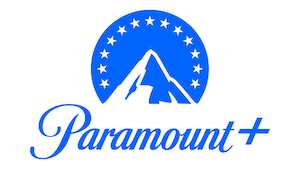To review the latest Deltrarune chapters means we must break the community’s most hallowed, unspoken rule: we don’t talk about Deltarune. Sure, there’s no shortage of theory-crafting and rambling essays – as was the case for the game’s previous installments, and its progenitor in Toby Fox’s seminal indie Undertale – but in the presence of the uninitiated and those just starting the latest episodes, we must remain tight-lipped, speaking only in broad strokes of “Deltarune is utterly profound gaming commentary” or “You will die laughing at Chapter 2.” (Or, well, just hiding our thoughts behind spoiler tags or self-contained subreddits. Avoid YouTube.)
But discuss it we must! And I say that not just because I’m under obligation as per my duties – because, really, why wouldn’t us Toby Fox faithful gush at length, having been champing at the bit for the past four (four!) years for the next chapter in his pixelated saga? Surely, we can take the opportunity to bend the rules on account of those aforementioned “broad strokes”, can’t we?
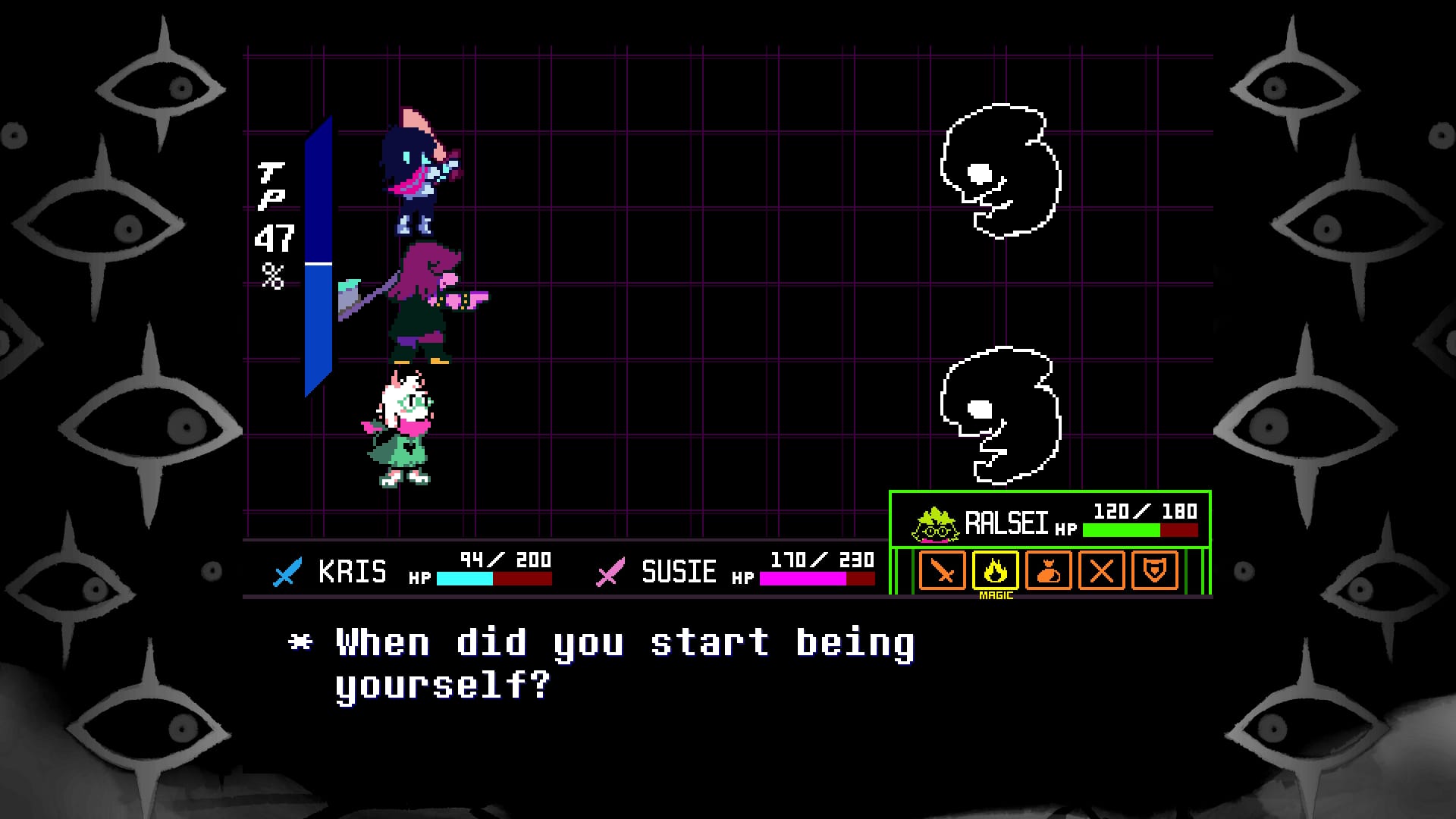
With the ongoing saga now available in one payable package, a recap is necessary: two schoolchildren – Kris, a human, and Susie, a lizard-esque monster – stumble into the parallel Dark World, wherein Ralsei, the realm’s dark prince, informs them of their role in restoring balance between light and dark, lest the world be destroyed by calamity. In sealing the Dark Fountains that give each Dark World form, the trio topples a mad monarchy lording over an Alice in Wonderland-themed playset (Chapter 1) and dodge malicious spam as they navigate cyberspace (Chapter 2).
Constructed within an RPG framework featuring bullet hell-based combat, Deltarune is not shy about paying tribute to its predecessor. The presentation’s certainly more advanced – Chapter 4’s thrilling climax throws in some neat 3D-esque parallax scrolling, even – but ultimately adheres to 8-bit pixels. The same “Spare” mechanic that defined Undertale’s morality means you don’t have to engage in outright fisticuffs; in fact, pacifism might even influence your game’s progress. Why, despite taking place in a new universe, familiar cameos big and small populate Kris’s hometown – some drive the narrative, many don’t, but all have their own story to tell from the woefully pathetic to the laugh-out-loud variety.
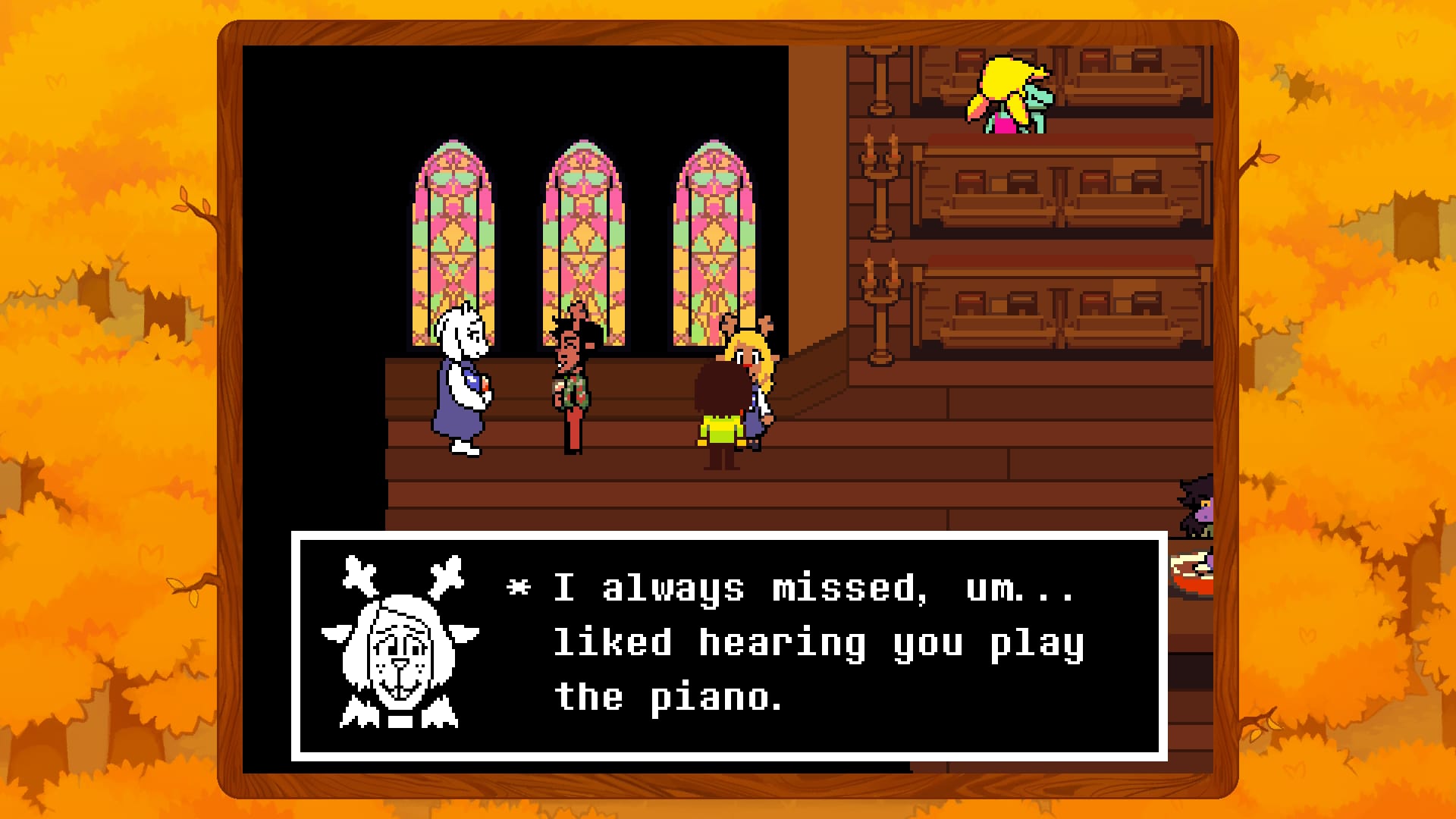
Is Deltarune an Undertale sequel? A parallel work? Such questions are what drive its rabid fanbase, still following the trail of nebulous crumbs tracing all the way back to 2015. Juxtaposing the two games displays obvious differences – Deltarune is an episodic narrative that, hitherto, doesn’t strictly adhere to Undertale’s plea for empathy – yet both subscribe to the same rich humanity not merely guiding its cast, but actively probing the relationship between game and player.
Which brings us to the one-two punch of Chapters 3 and 4 – both subscribing to the thematic undercurrents beating beneath Deltarune’s pixels, yet could not be further apart in their respective storytelling approaches. Whereas Chapter 3 is a madcap sugar rush in its tributes to television yesteryear, Chapter 4 offers a more harrowing approach in balancing daily-life minutiae, family trauma and soul-searching purpose.
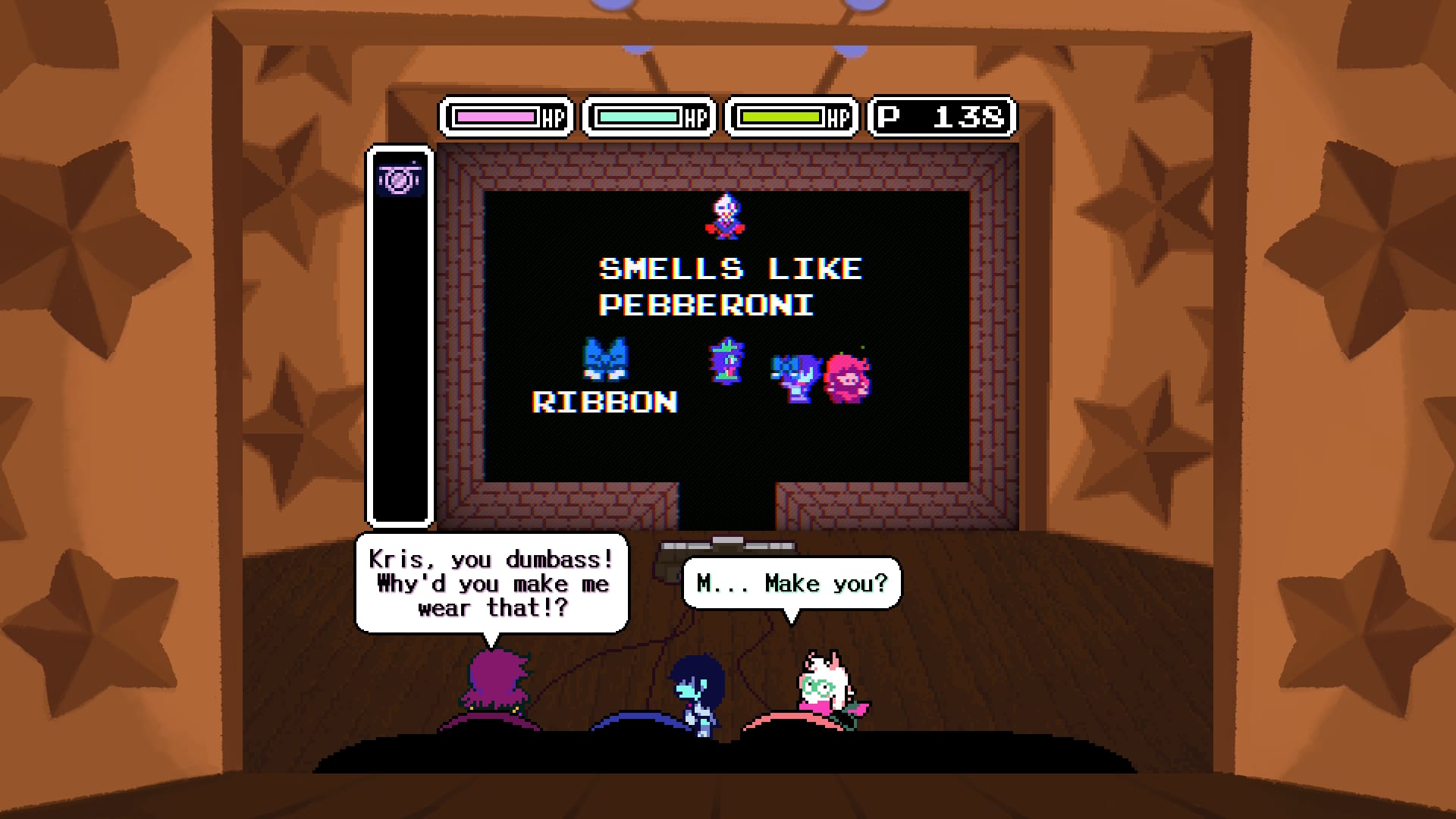
Chapter 3 spotlights the deceptive anarchy that is Toby Fox’s humor. From the rapid-fire gags courtesy of its animated GIF of an antagonist to the 8-bit gaming tributes, this circus of monuments to 80/90’s nostalgia thrills with laughter abound. Fox’s love for the gaming medium has shone throughout Deltarune’s entirety – not the least in how his games have served as RPG deconstructions – and that’s never been more evident than plopping our young heroes into a spontaneous couch co-op session. More than just endearing us further to the cast, the ensuing ribbing and mischief directly imports our youth in a manner not entirely unlike DS’s Retro Game Challenge. (Who among us hasn’t switched controllers when our friends weren’t looking?)
But as the layers peel back and reveal it’s not all fun and games, we’re not just indulging the precious memories forged with families and friends sitting around the boob tube – we’re left asking just how valuable is nostalgia, really? We idolize it as a monument to innocence and simpler times, but treasured memories of childhood gaming and family get-togethers are just that: mental exhibits that, while fun to revisit, shouldn’t shackle us to the past with hollow replications. (Which, of course, raises uncomfortable questions as to whether rose-tinted glasses potentially mask our respective traumas.) Such introspection’s enough to forgive the chapter for spinning its absurdist wheels – for all the character development, the overall plot gradually comes to a halt, and the absence of a post-world cooldown means we’re given little reprieve from all the zaniness. (Save for one sequence; you’ll know it when you see it.)
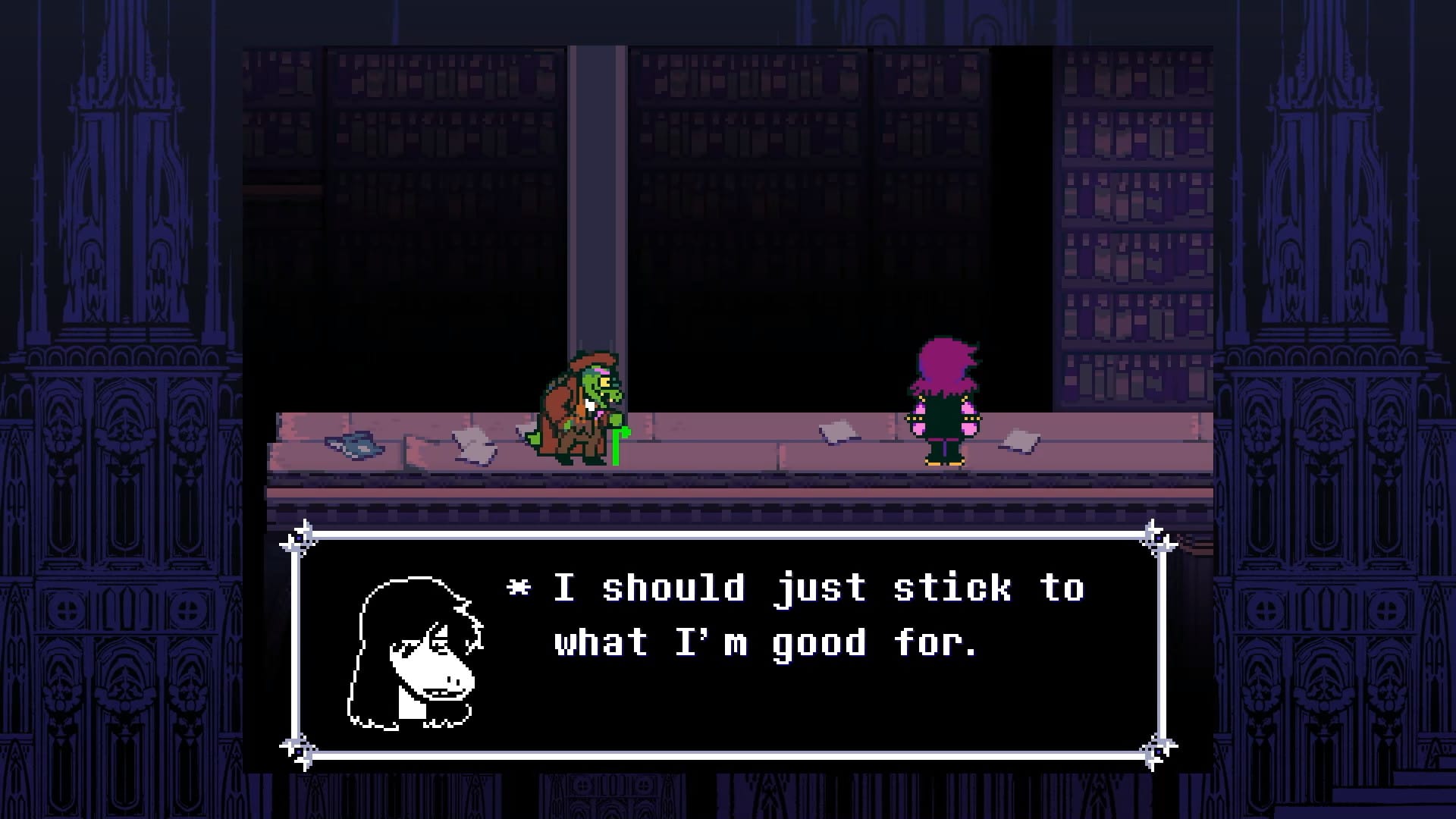
These questions pave a cold segue into Chapter 4, its church-inspired setting presenting a more balanced glimpse into Deltarune’s world. From broken families, to post-mortems, to apocalyptic boss fights, it raises the stakes by putting the party’s bonds to the test, not the least in its character study of Susie. While the unrestrained anarchy she’s displayed suggests a free spirit, the deep baggage we’ve long suspected her to carry impeded her desire for connection. Each consecutive trip to the Dark World represented a step outside the self-imposed shell guising her tough girl exterior, and from tender study sessions to pushy octogenarians, she’s fully come into her own as the game’s true star. (Really, the budding relationship between her and Noelle? Adorable.)
Not that the other two don’t have anything going on – we could elaborate upon Ralsei’s mask of false optimism finally beginning to slip as the so-called “Prophecy” moves forward (“I’m smiling!” being perhaps Deltarune’s most poignant line yet), or how the storytelling contrast between Kris and Susie may well prove the game’s most ironic tragedy, but alas, I’ve bent the Fight Club rule far enough. What I can say is that while Toby Fox is not the first game developer to experiment with the boundaries separating player and game, few have matched his ability to question our roles so directly – as if imposing ourselves upon Kris’s life is akin to treading upon sacred ground, hungry for the forbidden fruit that is Deltarune’s mystery box.
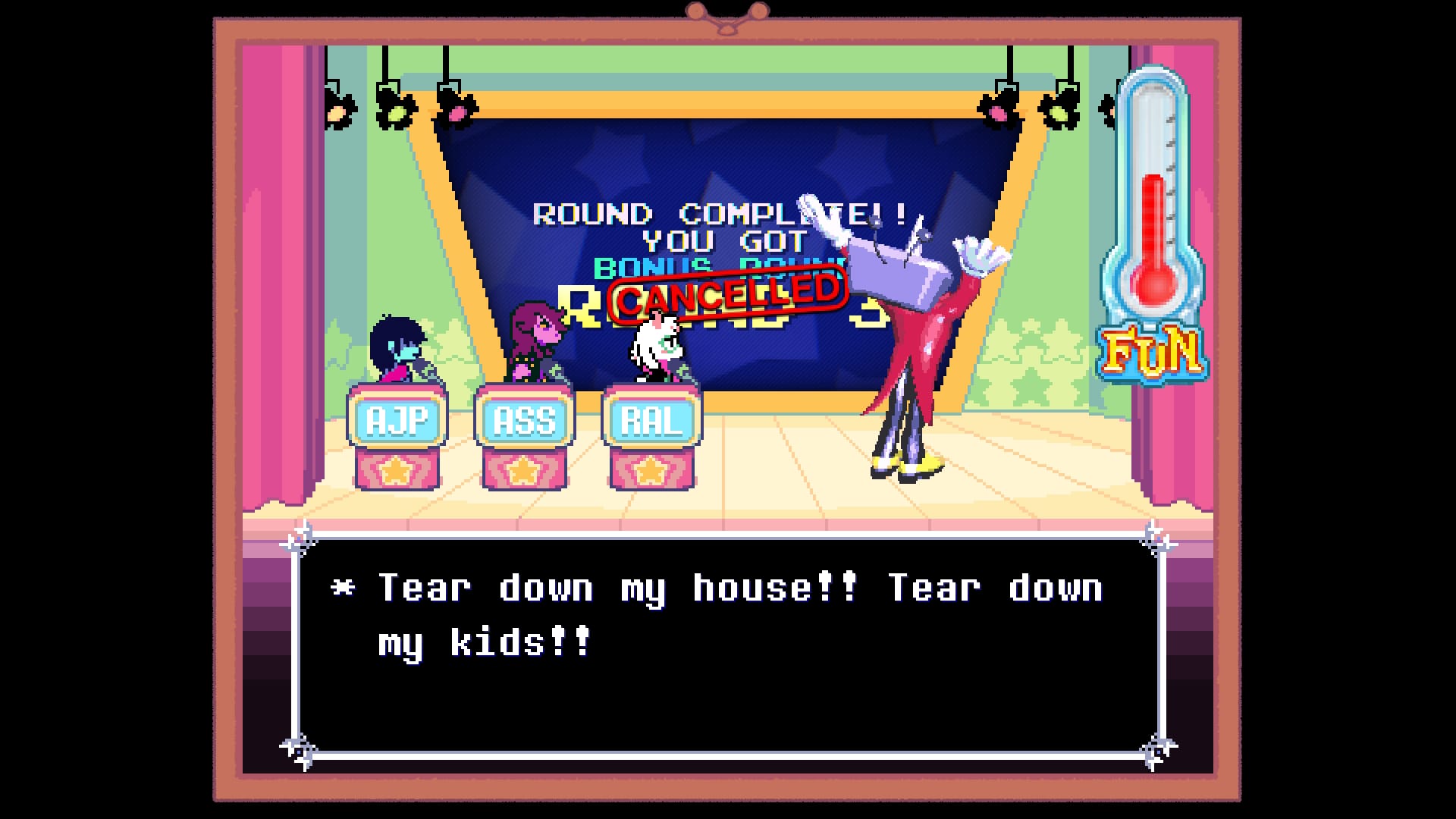
It’s the bedrock of what makes Deltarune “Deltarune” – persisting in its identity as a living, breathing video game, analyzing the human condition’s relationship to our favorite hobby with the same reverence in entertaining and engaging us with in-jokes, homages and shitpost memes. Gradually constructing the Jenga puzzle of a decade-old Undertale crackship? Check. Ralsei’s non-consensual plushie intruding upon Tenna’s big show? Check. Blink-and-you’ll-miss-it EarthBound references? Keep your ears open.
Deltarune is a work that thrives on its density – the more you prod at it, poke it, and explore it, the more it invites you into its world. Everything from hidden dialogue to nebulous items are but pieces of its ever-growing puzzle, inviting theory after theory; playthrough after playthrough in its compact, self-contained (or perhaps not-so-self-contained) episodes. Now that we’ve reached the halfway point, we’re only left asking this: how much deeper does this subversive rabbit hole go?
Deltarune
Excellent
Toby Fox’s latest exercise in brain-picking arrives with brand spankin’ new chapters that’re well worth the wait. From gut-busting laughs to profound gaming commentary, it’s little wonder Deltarune has captivated players as Undertale before it. You owe it to yourself to play this modern classic in the making.
Pros
- -Subversive framework in a class of its own.
- -Unbelievable density in its storytelling/world-building. Every inch demands scrutiny.
- -Fantastic blend of retro graphics and chiptune/modern music.
- -Ridiculously funny. On that note, Rouxls Card (pronounced “Rules Card”) is still possibly the greatest game character ever created.
Cons
- -Chapter 3 gets a little *too* exhausting.
This review is based on a retail Nintendo Switch 2 copy provided by the publisher.












